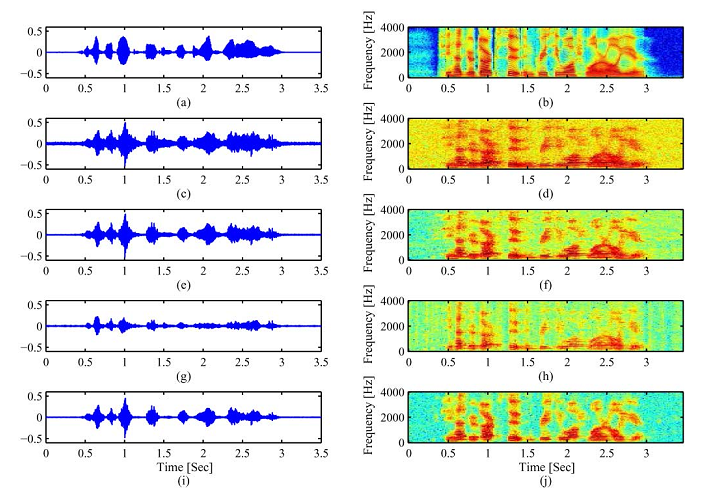Speech dereverberation and noise reduction are extremely important for hands-free speech communication systems, especially when the desired talker is far away from the microphone in a closed room. This is because both the reverberation and the noise may seriously reduce speech intelligibility and quality.
Unlike the existing algorithms that may degrade when both the noise and the reverberation are presented in practical situation, ZHENG et al. from the Institute of Acoustics, Chinese Academy of Sciences introduce a novel speech dereverberation and noise reduction algorithm in the linear prediction (LP) residual domain. They use a constrained minimum mean square error (MMSE) LP Residual Estimator (LPRE), based on the fact that both late reverberation and noise are additive components in the residual domain.
To implement the proposed algorithm of the constrained MMSE generalized singular value decomposition (GSVD)-based LPRE (CMMSE-GSVD-LPRE) in practice, the LP residuals are estimated continuously for both the reverberation and the noise, where a non-VAD noise power spectral density estimator and an incessant late reverberant spectral variance estimator are introduced.
In the following, the proposed algorithm is compared with the spectral subtraction (SS)-based algorithm and the traditional LP residual-based algorithm, and their performance is evaluated in two different environments including the noise-free, the reverberant and the noisy environments. To give quantitative comparisons, the speech to reverberation modulation energy ratio (SRMR) and PESQ score are selected to compare the three algorithms.
By properly setting the value of the re flection coefficient, the reverberation time ranging from 400 ms to 1000 ms is considered to evaluate the performance of the three algorithms. The result shows that all of the three algorithms can improve the values of the SRMR, while the proposed algorithm has the largest values of the SRMR among the three algorithms. And the PESQ scores also show that the proposed algorithm has the largest values in most cases.
In the reverberant and noisy environment, the reverberation time T60=400 ms is a fixed value, and only the white Gaussian noise is added to the reverberant speech for the space limitation, where the input SNR ranges from - dB to 25 dB. The comparison results reveal that the proposed CMMSE-GSVD-LPRE has the largest values of the SRMR among the three algorithms. In addition, the LP speech dereverberation (LP-SD) could not improve the PESQ score in noisy environments in all cases, while both the SS and the proposed algorithms can improve the PESQ score.
By studying the periodograms of the enhanced speech signals by the three algorithms as shown in Fig. 1, it is found that the SS contains lots of audible musical noise components, while the LP-SD could not remove the noise in most cases and only the late reverberation is partially removed. Compared with the LP-SD, the proposed CMMSE-GSVD-LPRE can remove both the noise and the reverberation. Compared with the SS, the proposed algorithm has less speech distortion and does not suffer from serious musical noise problem.

Fig.1 Waveform and spectrograms of (a)(b) the clean speech,(c)(d) the reverberant and noisy speech with T60=400 and the input SegSNR = 15 dB, (e)(f) enhanced by SS, (g)(h) enhanced by LP-SD, (i)(j) enhanced by the proposed approach (Image by ZHENG).
This research was supported in part by the National Science Fund of China (NSFC) under Grants 61201403 and 61302126 and in part by the Tri-Networks Integration Grant KGZD-EW-103-5(3).
References:
ZHENG Chengshi, PENG Renhua, LI Jian, LI Xiaodong. A Constrained MMSE LP Residual Estimator for Speech Dereverberation in Noisy Environments. IEEE Signal Processing Letters (vol. 21, no. 12, pp.1462-1466, December 2014). DOI:10.1109/LSP.2014.2340396
Contact:
ZHENG Chengshi
Communication Acoustics Laboratory, Institute of Acoustics, Chinese Academy of Sciences, 100190 Beijing, China
Email: cszheng@mail.ioa.ac.cn


